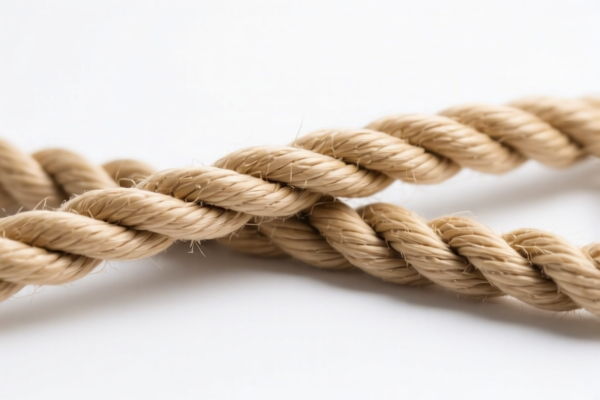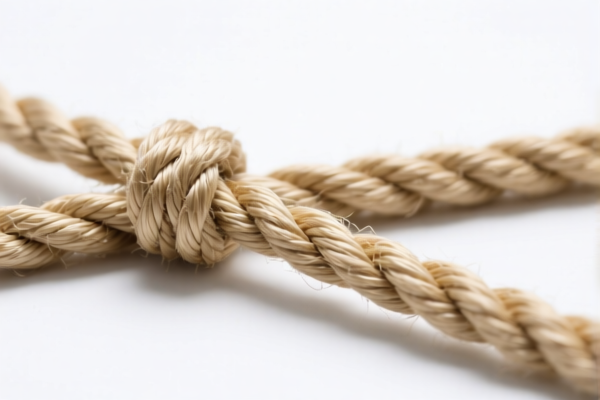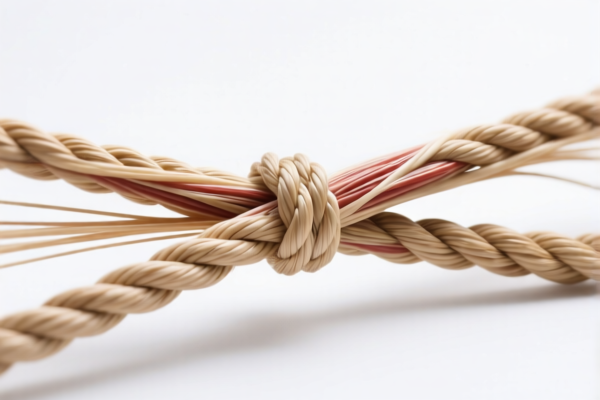| HS Code | Official Doc | Tariff Rate | Origin | Destination | Effective Date |
|---|---|---|---|---|---|
| 5607909000 | Doc | 61.3% | CN | US | 2025-05-12 |
| 5607493000 | Doc | 58.6% | CN | US | 2025-05-12 |
| 5609001000 | Doc | 57.9% | CN | US | 2025-05-12 |
| 5609004000 | Doc | 58.9% | CN | US | 2025-05-12 |
| 5404198080 | Doc | 61.9% | CN | US | 2025-05-12 |
| 5404191000 | Doc | 57.7% | CN | US | 2025-05-12 |
| 5301100000 | Doc | 55.0% | CN | US | 2025-05-12 |
| 5301300000 | Doc | 55.0% | CN | US | 2025-05-12 |
| 5306100000 | Doc | 55.0% | CN | US | 2025-05-12 |
| 5306200000 | Doc | 55.0% | CN | US | 2025-05-12 |




Legged Ropes
Legged ropes, also known as bell ropes or lanyards with stops, are specialized ropes incorporating strategically placed knots or stops (often called “legs”) along their length. These features serve to create distinct sections and enhance functionality for specific applications.
Material
Historically, legged ropes were commonly constructed from natural fibers like manila, hemp, or sisal. Modern applications frequently utilize synthetic materials such as polypropylene, nylon, or polyester for increased strength, durability, and resistance to weathering. The choice of material depends on the intended load, environment, and desired lifespan.
Purpose
The primary purpose of legged ropes is to provide controlled sections for tasks requiring specific lengths or to prevent the entire rope from being pulled through a device. The legs act as positive stops, limiting the rope’s movement and maintaining a consistent working length.
Function
- Load Distribution: Legs can help distribute load more evenly along the rope's length, reducing stress on any single point.
- Length Control: The fixed distances between legs provide predictable and repeatable lengths for applications like marking or measurement.
- Positive Stops: Preventing the rope from completely passing through a block, fitting, or other device.
- Grip Points: Legs offer convenient gripping points for users.
Usage Scenarios
- Bell Ringing: Traditionally used as bell ropes in church towers, where the legs prevent the rope from being pulled entirely through the bell chamber. The number and spacing of legs are critical for efficient ringing.
- Maritime Applications: Employed in boat mooring, rigging, and handling lines where controlled lengths and positive stops are required.
- Construction & Rigging: Used for lifting, lowering, and securing loads, providing controlled descent or ascent.
- Stagecraft & Theater: Utilized for sandbags, counterweights, and other stage rigging applications.
- Climbing & Rescue: Though less common now with specialized gear, they can be used in specific rescue scenarios or for creating fixed lengths in certain systems.
- Decorative Purposes: Used in nautical decor, knotwork, and ornamental displays.
Common Types
- Short-Legged Ropes: Feature closely spaced legs, often used where precise control and frequent gripping points are needed.
- Long-Legged Ropes: Have widely spaced legs, suitable for applications requiring longer sections and fewer stops.
- Bell Ropes: Specifically designed for bell ringing, with a standardized number of legs and a specific lay (twist) to facilitate efficient ringing. The number of legs varies depending on the bell's size and the ringing style.
- Hand-Knotted Legged Ropes: Made with individually tied knots to create legs, often used for decorative or specialized applications.
- Machine-Made Legged Ropes: Produced using machinery to create consistent and evenly spaced legs, common in industrial applications.
Based on the provided information, “legged ropes” can be classified under several HS codes, depending on the material and specific characteristics. Here's a breakdown of potential classifications:
-
5607.90.90.00: This HS code covers “Twine, cordage, ropes and cables, whether or not plaited or braided and whether or not impregnated, coated, covered or sheathed with rubber or plastics: Other: Other”. This is a broad category for ropes and cordage not specifically classified elsewhere. It applies to ropes made from various materials, including synthetic fibers, and covers those with or without coatings. The total tax rate is 61.3%.
-
5607.49.30.00: This HS code covers “Twine, cordage, ropes and cables, whether or not plaited or braided and whether or not impregnated, coated, covered or sheathed with rubber or plastics: Of polyethylene or polypropylene: Other: Other”. If the “legged ropes” are made of polyethylene or polypropylene, this code applies. The total tax rate is 58.6%.
-
5609.00.40.00: This HS code covers “Articles of yarn, strip or the like of heading 5404 or 5405, twine, cordage, rope or cables, not elsewhere specified or included: Other”. This code is applicable if the ropes are made from yarn or strip not covered by other headings and are not specifically classified elsewhere. The total tax rate is 58.9%.
-
5404.19.80.80: This HS code covers “Synthetic monofilament of
67 decitex or more and of which no cross-sectional dimension exceeds 1 mm; strip and the like (for example, artificial straw) of synthetic textile materials of an apparent width not exceeding 5 mm: Monofilament: Other: Other Other”. If the ropes are made of synthetic monofilament meeting the specified decitex and dimension requirements, this code applies. The total tax rate is 61.9%.
It is important to determine the exact material composition of the “legged ropes” to select the most appropriate HS code. If the ropes are made of cotton, HS code 5609.00.10.00 would be applicable.
Regarding any of these HS codes, please note that the tax rates are subject to change, and the 25.0%加征关税 will increase to 30.0% after April 2, 2025.
Customer Reviews
No reviews yet.